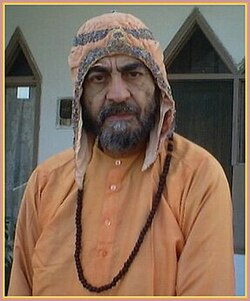BISHAN SINGH, GIANI (1875-1966), cleric and exegete, was a granthi or priest at the Khalsa College at Amritsar for 30 years. The Khalsa College was then a premier Sikh college excelling in research and publication in the field of Sikh studies. Four of the foremost Sikh scholars of this period, namely Bhai Jodh Singh, Prof. Asor Teja Singh, Bhai Sahib Singh and Dr Ganda Singh, were members of the college faculty and between them they brought about a major enlightenment in Sikh letters.
CHABBA, a village 10 km south of Amritsar (31° 38`N, 74° 52`E) along AmritsarTarn Taran road, has a historical shrine called Gurdwara Sangrana Sahib. The Gurdwara itself is so named because, according to local tradition, one of the battles (sangram in Hindi and Punjabi) of Amritsar between Guru Hargobind (1595-1644) and the Mughal troops was fought here. Another tradition connected with the place is that Sulakkhani, a childless woman of the village, asked for and received a boon from Guru Hargobind as a result of which she subsequently became the mother of seven sons.
DAN SINGH, a Brar Jatt of the village of Mahima Sarja in present day Bathinda district of the Punjab, joined along with his son the contingent of Brars raised by Guru Gobind Singh after his escape from Chamkaur in December 1705. Dan Singh by virtue of his devotion and daring soon won the Guru`s trust as well as the leadership of the Brar force. The anonymous author of Malva Des Ratan di Sakhi Pothi states that he was appointed asupali (asvapa/,) or keeper of horses. It was at his suggestion that Guru Gobind Singh chose a high ground near the dhab or pool of Khidrana (now known as Tibbi Sahib near Muktsar), to defend himself against the pursuing host of the faujdar of Sirhind.
DHILVAN KALAN, village 5 km southeast of Kot Kapura (30° 35`N, 74° 49`E) in Faridkot district of the Punjab, was the abode of Sodhi Kaul, shortened from Kaulnain, a descendant of Guru Arjan`s elder brother, Prithi Chand, and thus a collateral relation of Guru Gobind Singh. According to Bhai Santokh Singh, Sri" Gur Pratap Suraj Granth, Guru Gobind Singh, displeased at Chaudhari Kapura`s refusal to assist him in warding off the pursuing army from Sirhind, left Kot Kapura and came to Dhilvari Kalari, where Sodhi Kaul and his four sons received him with honour.
FATEH SINGH (d. 1716), an army commander under Banda Singh Bahadur, who was appointed administrator of Samana after the town was occupied by the Sikhs in 1709. Fateh Singh participated in several of Banda Singh`s battles against the Mughal rulers. In the battle of Sirhind fought at the nearby village of Chappar Chiri, Fateh Singh killed Nawab Wazir Khan, the faujdar of Sirhind. He was taken prisoner at Lohgarh in December 1710 and, after several years in jail, was executed in Delhi in June 1716 along with Banda Singh and his other companions.
GOIND, BHAI, a Ghei Khatri of Sultanpur Lodhi, embraced the Sikh faith in the time of Guru Amar Das. He took part in sevd for the digging of the sacred pool at Amritsar under Guru Arjan. Bhai Gurdas describes Bhai Goind in his Varan, XI.20, as one of the leading disciples of the Guru. GOIND, BHAI, also known as Bhai Gonda (1569-1649), head of a dhudn, seat or branch of Udasi Sikh preachers, was born on 27 July 1569 in a Khatri family of Srinagar in Kashmir.








